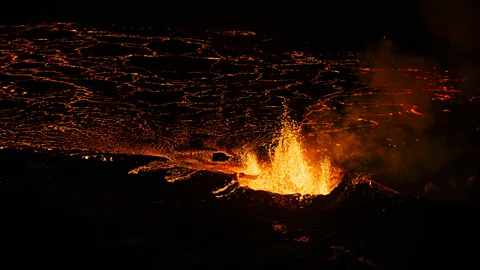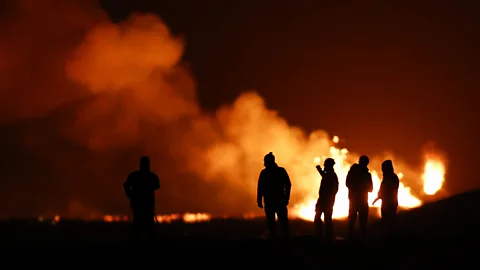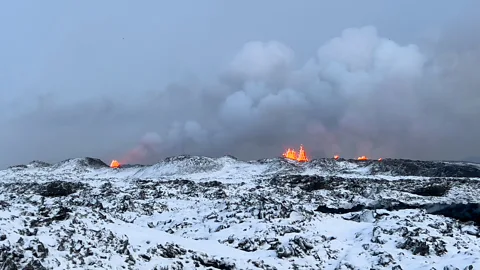Iceland volcano: What it's like to live with the fires of Reykjanes
 Getty Images
Getty ImagesAfter 800 years, volcanic activity has returned to Reykjanes, Iceland, and it might last hundreds of years. Watching from Reykjavík, the writer Andri Snaer Magnason reflects on the Icelandic relationship with volcanoes – and a close encounter he had with lava.
I can see the glow in the sky from my home in Reykjavík. Before it was quite a hassle to see an eruption – they happened hundreds of kilometers away – but right now in Iceland, it's inescapable. On my social media timeline, I see variations of the same view: a red glowing sky and a distant curtain of fire burning in the Reykjanes Peninsula.
We feel safe in Reykjavík – most people feel more awe than fear – but a new volcanic phase has started in our backyard. The Reykjanes Peninsula volcanic system is waking up again, after almost 800 years of sleep. The last phase lasted about 400 years, from 800 to the late 1200s.
 Getty Images
Getty ImagesIt started in 2021. After a series of 40,000 earthquakes, a tiny volcano was born in Fagridalur, a small remote valley close to the town of Grindavík. A friend called me, a photographer for one of the leading newspapers, and we rushed off to see it at 4:00 in the morning. We took a rugged road towards a glow behind a small mountain, parked the car and headed off on foot.
You may also like:
It was dark and foggy. We headed for the brightest area in the landscape, and after about one hour we saw this strange glow in the mist. Our eyes were not sure what to grasp – the light looked like the glow from a little town. But as we came closer, we saw orange rivers of molten rock and then finally a clear picture emerged: a lava flow slowly claiming the vegetation in the bottom of the valley.
On top of a small hill was the volcano, with a fountain of lava that was small enough to fit in an Italian town square. It looked like it was the closest Earth can get to the volcano in the children's story of The Little Prince, which he uses to heat his breakfast. The beauty was seducing, so we came very close, until the heat burnt our faces. To fulfill a childhood dream, I took my hiking pole and poked the red flowing lava. It did not intrude, answering a question I'd had since I was a boy: would you sink if you fell in?
The volcano was not only visually amazing; so was the sound. I was astonished by how soft it actually was: not a roaring thunder, because volcanic matter is soft and the pool of lava can work almost as a woofer, creating a pulse-like sound, like a breathing dragon. (Listen to the seismic sound of Iceland's newest volcanic eruption.)
Soon more people started coming, in the thousands. The volcano was perfectly placed, almost like an amphitheatre. In the winter evening, families and friends had a volcanic picnic and some kids even came with sticks to roast marshmallows. By then the soundscape was lost to drones buzzing around, airplanes and helicopter traffic, as well as the chatting and singing of visitors.
In Iceland, our history is interwoven and shaped by volcanic activity, but to get so close to a volcano in a relatively safe way is extremely rare. Fagradalsfjall was almost perfect for visitors. It erupted again in 2022, and once more in the summer of 2023. By then the eruption site had a parking lot with a parking fee, paths and signs showing the way, even a food truck at the start of the path. The local search-and-rescue team was extremely generous, providing volunteers to keep everyone safe. Personally I went about 15 times, amazed how every time the place was different, and seeing a valley eventually become a mountain.
When I was a teenager, before the time of the internet, few people had heard about Iceland. We could tell people all sorts of nonsense about our lives to answer rather silly questions. I told people we were modern, we had lights on our Viking helmets, we lived in five-storey igloos, and we were the last civilisation in the world that still had a mating season, because our kids had to be born in October to survive the winter. The Fagradalsfjall volcano would have fit perfectly into that kind of storytelling: "When we are cold in the winter, we hike to the volcano to get warm and roast marshmallows with the family."
But this time it was true. Geologists, seismologists and volcanologists became household names. An average person can name their five favourites, and geological terminology has become a part of our daily vocabulary.
 Getty Images
Getty ImagesArchaeologists in Iceland use ash layers to identify the age of their findings. Very little has been found beneath the "settlers layer" – a layer of ash from the year 877, the time the first settlers from Norway and the British Isles came to Iceland. Through volcanoes you can even trace our way of thinking. The last time the Reykjanes system was active was during the times when our Parliament, the Althing, decided we should become Christian in the year 1000. When a volcano subsequently erupted, the believers in the Norse gods said: Look! Now the gods are angry! But then the chief of the Christian side pointed out: What angered the gods when the lava ran that we are standing on now?
This dualism, and the idea that we can "anger the gods" through our actions, might still be installed in our psyche. The last three eruptions were overtaken by Instagram influencers with their half-melted drones, and we might have been too amused to remember what kind of force we are dealing with. Economists were already measuring the benefit of volcanic activity for economic growth, the value of the publicity, the good branding and increased tourism. When the Earth started rumbling directly under the hydrothermal waters of the Blue Lagoon, the icon of tourism in Iceland, a friend of mine said: "This is what you get when you ask for a tourist eruption!"
 Getty Images
Getty ImagesIceland's dark lullabies
At the darkest time of the year in Iceland, scary creatures come out to play. For example, children hear stories about Gryla, the 900-year-old child-eating hag and her 13 troll sons – the Yule Lads.
In a documentary for BBC Radio 4, the Icelandic writer and director Andri Snær Magnason explores the unusual Christmas stories and traditions of his home country, travelling from farmstead to lava field: do the elves still crash your house to throw a Christmas party and will the cows still talk on New Year's Eve? And what happens when you have to spend Christmas alone, locked inside Ikea? LISTEN.
So now we are just waiting. Life goes on in Reykjavík and in the rest of the country. Unlike the eruptions of Eyjafjallajökull in 2010, flights are not delayed, despite the airport being quite close. This volcano is not the type that fills the sky with ash. The locals of Grindavík will have to keep living with uncertainty. How long will it last: one day, one month, two months? Will it hit the town, and if not, should we fix the damage and rebuild it? After nature hits us, the Icelandic way has been to rebuild.
That's what we did after the Westman Islands eruption in 1973, after the avalanches in Flateyri and Súðavík in 1995, and after the landslide in Seyðisfjörður in 2020. But if this eruption does not claim the town today, it might wake up again next year, and maybe continually over the next 200 years. This long-term prospect also makes us think, could other regions be affected? A great part of the Reykjavik capital region is built on the Reykjanes volcanic system.
Despite all the unknowns, it feels like these events unite us as Icelanders. In a world where we are increasingly polarised by social media, it is refreshing to have volcanologists as household names, and with their warnings, the volcanoes are mostly a threat to infrastructure rather than lives. What's happening now is not a tourist eruption, much bigger and more powerful than the last one. But the beauty is even more seductive, and for those of us watching from a distance, it provokes amazement, awe and wonder.
It's a reminder of how fortunate we are to live on the Earth's thin crust, somewhere between the heat of the Sun and the blistering temperatures of the fire below the ground.
* Andri Snaer Magnason is an Icelandic writer and documentary film director based in Reykjavik.
--
If you liked this story, sign up for The Essential List newsletter – a handpicked selection of features, videos and can't-miss news delivered to your inbox every Friday.
